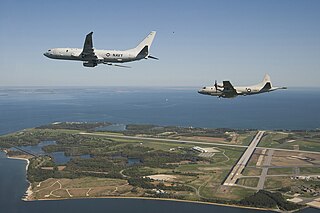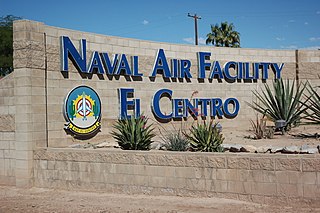
Naval Air Station Fallon or NAS Fallon is the United States Navy's premier air-to-air and air-to-ground training facility. It is located southeast of the city of Fallon, east of Reno in western Nevada. Since 1996, it has been home to the U.S. Navy-Fighter Weapons School (TOPGUN) taking over from the former NAS Miramar, California, and the surrounding area contains 240,000 acres (97,000 ha) of bombing and electronic warfare ranges. It is also home to the Naval Aviation Warfighting Development Center (NAWDC), which includes TOPGUN, the Carrier Airborne Early Warning Weapons School (CAEWWS) and the Navy Rotary Wing Weapons School. Navy SEAL Combat Search and Rescue (CSAR) training also takes place there.

The Pacific Missile Range Facility, Barking Sands is a U.S. naval facility and airport located five nautical miles (9 km) northwest of the central business district of Kekaha, in Kauai County, Hawaii, United States.

Naval Air Weapons Station (NAWS) China Lake is a large military installation in California that supports the research, testing and evaluation programs of the United States Navy. It is part of Navy Region Southwest under Commander, Navy Installations Command, and was originally known as Naval Ordnance Test Station (NOTS).

Naval Air Station Jacksonville is a large naval air station located approximately eight miles (13 km) south of the central business district of Jacksonville, Florida, United States.
The Harvey Point Defense Testing Activity facility, owned by the Department of Defense, is located on a peninsula in Perquimans County, North Carolina, along Albemarle Sound, near the town of Hertford, NC. It was established in World War II as Naval Auxiliary Air Station Harvey Point, an operating base for sea planes conducting anti-submarine surveillance off the Atlantic coast. A close by naval facility, Naval Air Station Weeksville, served as a blimp base from 1941 to 1957, while another former naval air facility remains active as Coast Guard Air Station Elizabeth City.

Naval Air Station Patuxent River, also known as NAS Pax River, is a United States naval air station located in St. Mary’s County, Maryland, on the Chesapeake Bay near the mouth of the Patuxent River.

Naval Air Station North Island or NAS North Island, at the north end of the Coronado peninsula on San Diego Bay in San Diego, California, is part of the largest aerospace-industrial complex in the United States Navy – Naval Base Coronado (NBC), and the home port of several aircraft carriers of the United States Navy.

Naval Air Facility El Centro or NAF El Centro is a United States Navy Naval Air Facility located approximately six miles (10 km) northwest of El Centro, in Imperial County, California. NAF El Centro is under the jurisdiction of Navy Region Southwest and serves both as temporary homeport to military units conducting air-to-air and bombing training, and as the winter training home of the Blue Angels aerobatics display team.

Naval Base Ventura County (NBVC) is a United States Navy base in Ventura County, California. Formed by the merger of NAS Point Mugu and CBC Port Hueneme, NBVC is a diverse installation composed of three main locations — Point Mugu, Port Hueneme, and San Nicolas Island. The base serves as an all-in-one mobilization site, deep water port, railhead, and airfield. NBVC supports more than 100 tenant commands with a base population of more than 19,000 personnel, making it the largest employer in Ventura County.

The Clinton-Sherman Industrial Airpark, also known as the Oklahoma Air & Space Port is a spaceport in Washita County, Oklahoma, near the town of Burns Flat. The Federal Aviation Administration (FAA) granted a license to the site in June 2006 to the Oklahoma Space Industry Development Authority (OSIDA) to "oversee the takeoff and landing of suborbital, reusable launch vehicles." It also boasts the first space flight corridor, "The Infinity One"—which is about 152 miles long and averages about 50 miles wide—that is not in restricted airspace and does not interfere with Military Operations Areas (MOAs). The facility is an FAA licensed launch site, one of only 12 in the U.S. Individual operators must also secure a separate license in order to make space flights from the facility.

Naval Air Station Key West, is a naval air station and military airport located on Boca Chica Key, four miles (6 km) east of the central business district of Key West, Florida, United States.

Naval Base Coronado (NBC) is a consolidated Navy installation encompassing eight military facilities stretching from San Clemente Island, located seventy miles west of San Diego, California, in Los Angeles County, California, to the Mountain Warfare Training Camp Michael Monsoor and Camp Morena, located sixty miles east of San Diego.

DeLand Municipal Airport, also known as Sidney H. Taylor Field, is a city-owned public-use airport located three nautical miles (5 km) northeast of the central business district of DeLand, a city in Volusia County, Florida, United States.
The S-99 experimental submarine was the only ship of the Project 617 class that the Soviet Union built during the early Cold War. She was the only Soviet submarine which used a German Walter turbine fueled by high-test peroxide (HTP). Entering service in 1956, the boat was assigned to a training unit of the Baltic Fleet. S-99 was badly damaged by a HTP explosion in 1959 and was not repaired. The submarine was decommissioned in 1964 and subsequently scrapped.

Kaibōkan or coastal defense ship was a type of naval ship used by the Imperial Japanese Navy during World War II for escort duty and coastal defense. The term escort ship was used by the United States Navy to describe this category of Japanese ships.

Joint Base Charleston is a United States military facility located partly in the City of North Charleston, South Carolina and partly in the City of Goose Creek, South Carolina. The facility is under the jurisdiction of the United States Air Force 628th Air Base Wing, Air Mobility Command (AMC).

Naval Air Station Point Mugu was a United States naval air station near Oxnard, California, which operated as an independent base from 1941 to 2000, when it merged with nearby Naval Construction Battalion Center Port Hueneme to form Naval Base Ventura County.

















